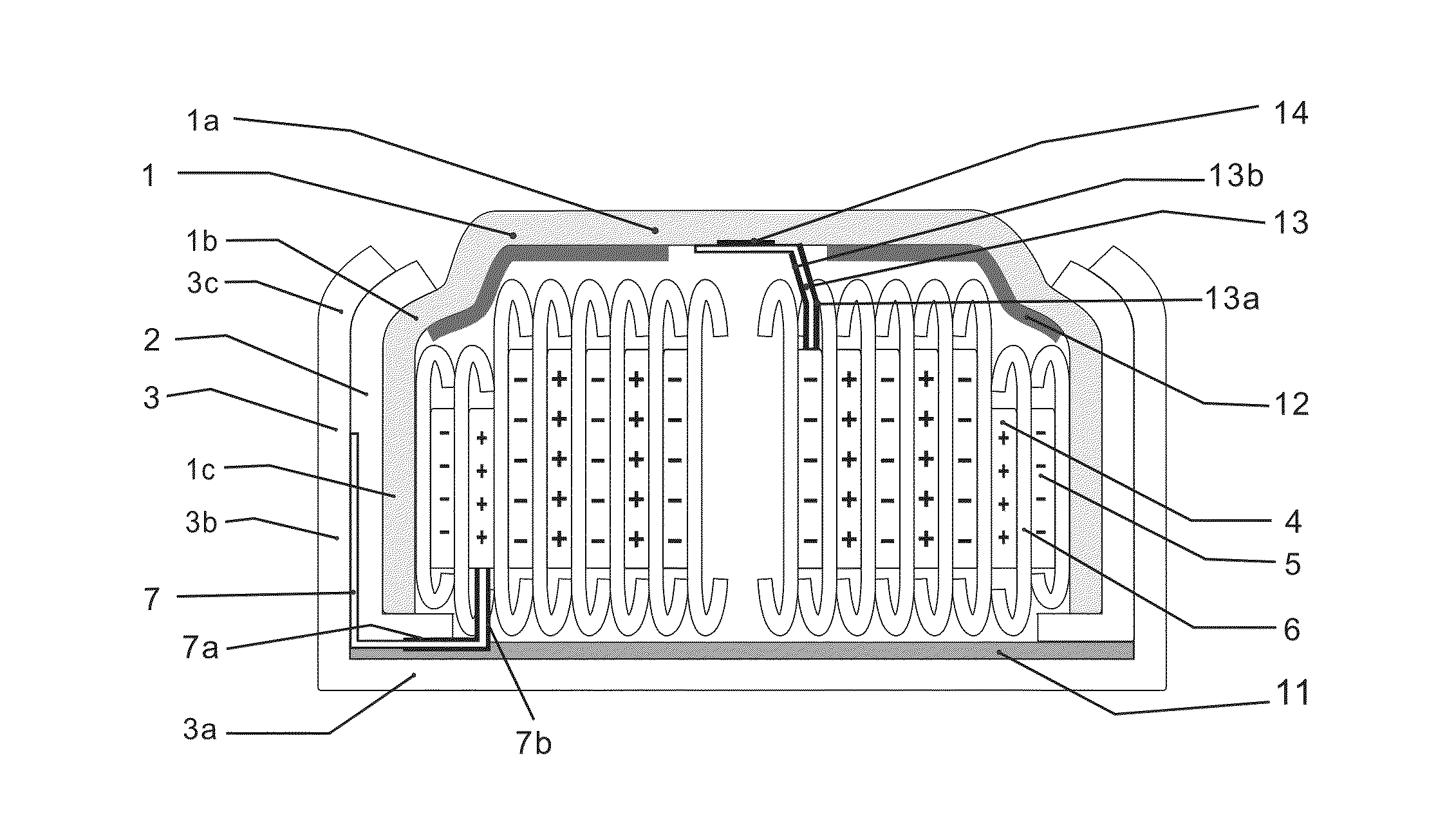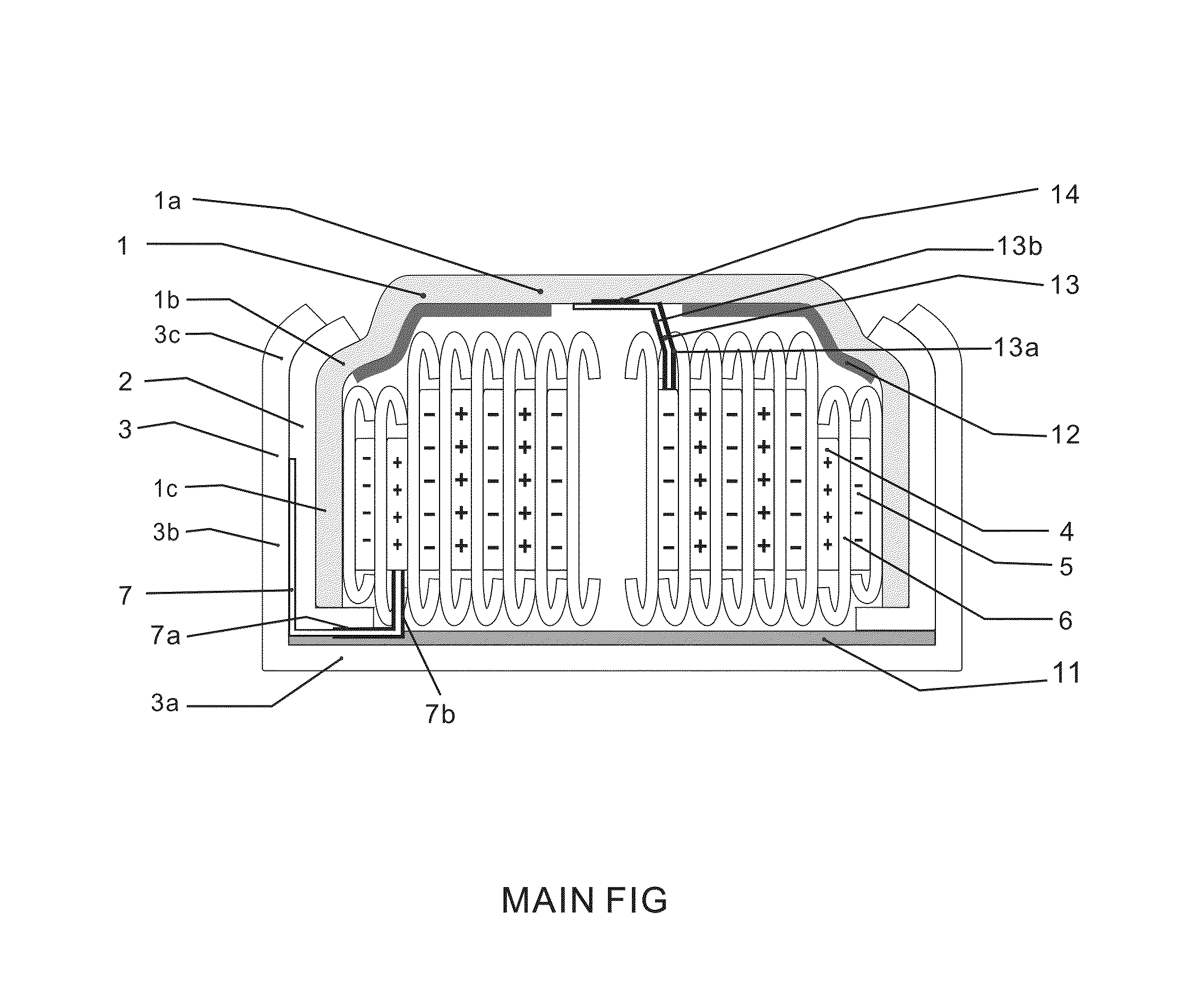Rechargeable Lithium Ion Button Cell Battery
- Summary
- Abstract
- Description
- Claims
- Application Information
AI Technical Summary
Benefits of technology
Problems solved by technology
Method used
Image
Examples
example 1
[0046]As per FIG. 1, inventors of the present invention manufactured some lithium-ion rechargeable button cells size Z23 at diameter 7.8 mm height 5.3 mm as per the details disclosed in the above description.
[0047]Battery casings 1 and 3 are made by nickel plated stainless steel grade 316, 304 or 430, of 0.10 mm to 0.15 mm thick, preferably at 0.125 mm thick. The anode casing sidewall 1c is single wall. Gasket 2 is made by injected polypropylene at 0.06 mm to 0.15 mm thick, preferably at 0.12 mm thick.
[0048]Vacuum mix the cathode lithium-intercalating materials preferably Li(Ni1 / 3Mn1 / 3Co1 / 3)O2 and other functional additives in NMP solvent thoroughly, and coat the slurry double sided on the aluminum foil usually 10 um to 25 um thick preferably 12 um thick, heat to dry the coated material and press it by a calendaring machine to get the desired thickness usually 0.1 mm to 0.2 mm. The coating is not on full area of the aluminum foil leaving a blank area uncoated for the battery tab 7. ...
example 2
[0054]As per FIG. 3, most of the parts, materials and procedures are the same as example 1, except that the cathode tab 7 is welded to a round metal flake 10 usually aluminum flake at 0.05 mm thick, as FIG. 5. Insulation washer 11a is a O ring shape adhesive tape, to be attached to flake 10 before ultrasonic welding, leaving the center metal exposed and then welded with conductor tab 7. After welding insulation washer 11 usually round is attached to the welding area to have all the naked metals covered. After the electrolyte being filled, the flake 10 is then turned down to cover the spiral wound roll and then the outer casing 3 is put onto this sub-assembly then the battery is finally crimped and sealed.
[0055]The battery made in this example has the similar performance as example 1, except that an extra aluminum flake 10 welded to conductor tab 7 and it brings risk of breaking the tab 7 at different assembly steps. It also occupies about 0.05 mm thickness of the battery inside spac...
example 3
[0056]As per FIG. 4, most of the parts, materials and procedures are the same as example 1, except that the cathode tab 7 is much longer and welded directly to the outer casing inner flat area 3a. The longer tab 7 can reach 3a by crossing the sidewall 3b down and then ultrasonic welded with 3a at area 8. Insulation washer 11a is a O ring shape adhesive tape, to be attached to outer casing bottom 3a before ultrasonic welding, leaving the center metal exposed and then welded with conductor tab 7. After welding insulation washer 11 usually round is attached to the welding area to have all the naked metals covered. The long neck of tab 7 will have to hold the outer casing 3 together with the spiral wound roll during all the steps afterward. After the electrolyte being filled, the outer casing 3 is then turned back from aside to cover the sub-assembly while the lengthy tab 7 must be carefully bended for several times to be contained inside of the battery housing, and then the battery is ...
PUM
 Login to View More
Login to View More Abstract
Description
Claims
Application Information
 Login to View More
Login to View More - R&D
- Intellectual Property
- Life Sciences
- Materials
- Tech Scout
- Unparalleled Data Quality
- Higher Quality Content
- 60% Fewer Hallucinations
Browse by: Latest US Patents, China's latest patents, Technical Efficacy Thesaurus, Application Domain, Technology Topic, Popular Technical Reports.
© 2025 PatSnap. All rights reserved.Legal|Privacy policy|Modern Slavery Act Transparency Statement|Sitemap|About US| Contact US: help@patsnap.com



